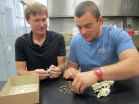Is dietary supplementation appropriate for children with autism spectrum disorder?
Not enough and too much are often the result, according to new study published in the Journal of the Academy of Nutrition and Dietetics
2015-06-04
(Press-News.org) Philadelphia, PA, June 4, 2015 - Children with Autism Spectrum Disorder (ASD) are often picky eaters, which can lead parents to suspect that their children might not be getting adequate amounts of vitamins and minerals. This sometimes leads parents of children with ASD to try nutritional supplements and dietary regimens such as gluten-free and casein-free (GFCF) diets without professional supervision. In the largest study of its kind, published in the Journal of the Academy of Nutrition and Dietetics, researchers report that these well-intentioned efforts can result in both insufficient nutrients and excessive nutrients. Despite supplementation, children with ASD still were deficient in calcium, for example, while some were consuming excessive amounts of vitamin A and other nutrients.
"Many families try a GFCF diet in an attempt to improve symptoms of ASD," explained lead investigator Patricia A. Stewart, PhD, RD, assistant professor of Pediatrics, the University of Rochester Medical Center. "While 19% of all Autism Speaks Autism Treatment Network (AS ATN) participants were reported to be on a GFCF diet, 12% of the children in the subgroup participating in this study were given a GFCF diet and were significantly more likely to use nutritional supplements (78% vs 53%), however, the micronutrient intake of children on or off the diet was remarkably similar."
A total of 368 children between 2 and 11 years of age were recruited from five AS ATN sites at Cincinnati Children's Hospital, University of Arkansas, University of Colorado, University of Pittsburgh, and University of Rochester. All had been diagnosed with Autistic Disorder, Asperger Disorder, or Pervasive Developmental Disorder as defined by the DSM-IV.
Three-day food records were completed for the children by their caregivers. A registered dietitian nutritionist trained the caregivers to record the amount of all foods, beverages and nutritional supplements consumed including brand names and recipes used for food preparation. In the case of nutritional supplements, photographs of the labels were taken to insure that ingredients were accurately recorded. Registered dietitian nutritionists verified these records and immediately called families if clarification was needed.
By examining these detailed eating records, investigators found that the children were consuming similar amounts of micronutrients as children without ASD. They also had the same deficits in vitamins D, E, calcium, potassium, and choline as the general pediatric population. Although ASD children are given supplements more often (56% vs. 31-37% of the general population), even after supplementation, 40-55% were lacking in calcium and 30-40% were lacking in vitamin D.
Children on the GFCF diet consumed more magnesium and vitamin E. This may be due to the substitution of soy and nut-based products. Children on this diet were more adequately supplemented with vitamin D. Calcium supplementation was equally inadequate in those on and off the diet.
Despite different eating behaviors, children with ASD received much of their needed micronutrients from food consumption. This might be due to the high levels of fortification in the modern food supply, where vitamins and minerals are often added. This fortification may also be responsible for the overconsumption of certain nutrients by children with ASD. For the supplement users in this study, many exceeded the Tolerable Upper Limit for safe intake levels of vitamin A, folic acid, and zinc.
"In clinical practice, each patient needs to be individually assessed for potential nutritional deficiencies or excess. Few children with ASD need most of the micronutrients they are commonly given as multivitamins, which often leads to excess intake that may place children at risk for adverse effects. When supplements are used, careful attention should be given to adequacy of vitamin D and calcium intake," Dr. Stewart noted.
INFORMATION:
ELSE PRESS RELEASES FROM THIS DATE:
2015-06-04
In a new study, scientists have gathered all available NASA/ESA Hubble Space Telescope data on the four outer moons of Pluto to analyse the system in more depth than ever before. The observations show that at least two of Pluto's moons are not neatly rotating on their axes but are in chaotic rotation while orbiting around Pluto and its companion Charon. The study also hints that one of the moons has a mysterious jet-black colouring. These surprising results appear in the 4 June issue of the journal Nature.
Almost every moon in the Solar System, including our moon, rotates ...
2015-06-04
SALT LAKE CITY, June 4, 2015 - At times during the past 10,000 years, cottontails and hares reproduced like rabbits and their numbers surged when the El Niño weather pattern drenched the Pacific Coast with rain, according to a University of Utah analysis of 3,463 bunny bones.
The study of ancient rabbit populations at a Baja California site may help scientists better understand how mammals that range from the coast to the interior will respond to climate change, says anthropology doctoral student Isaac Hart. He is first author of the study to be published in the ...
2015-06-04
A rare and elusive rabbit has been found, held and photographed by a researcher from the University of East Anglia (UEA).
The Annamite Striped rabbit, found in the forests of Laos and Vietnam, was first documented by rabbit expert Dr Diana Bell and colleagues from UEA's School of Biological Sciences in the journal Nature in 1999. It has rarely been seen since.
Researcher Sarah Woodfin, who is studying for a Masters in Applied Ecology and Conservation at UEA, set out on a three-month expedition to track the recently-discovered rabbit and study its habitat.
But she ...
2015-06-04
Many aquatic species have a reputation for negligent parenting. Having cast their gametes to the currents, they abandon their offspring to their fate. However, hands-on parenting is taken to a whole new dimension in the Syngnathidae fish family. Instead of leaving the responsibility to the females, seahorse and pipefish males take the pledge to care for their young even before the eggs are fertilized. The females depart soon after placing their eggs directly into the male's brood pouch, leaving the soon-to-be fathers to incubate the developing embryos. Ines Braga Goncalves ...
2015-06-04
Cancer has overtaken cardiovascular disease, which includes heart disease and stroke, as the UK's No 1 killer--but only among men, reveals research published online in the journal Heart.
Cardiovascular disease is still the most common cause of death among women, and kills more young women than breast cancer, the figures show.
The researchers used the latest nationally available data (2012-13) for each of the four UK countries and the Cardiovascular Disease Statistics 2014 report compiled for the British Heart Foundation (BHF) to quantify the prevalence of cardiovascular ...
2015-06-04
Researchers have developed a score that predicts an individual's risk of dying within 5 years for people aged between 40 and 70 years old in the UK, according to new research published in The Lancet.
The score, which uses measures that can be obtained by simple questionnaires without any need for physical examination, such as self-rated health and usual walking speed, could be used by individuals to improve awareness of their health status, and by doctors to identify high-risk individuals for further treatment, say the authors.
Individuals can calculate their personalised ...
2015-06-04
Women aged 50-69 years who attend mammography screening reduce their risk of dying from breast cancer by 40 per cent compared to women who are not screened - according to a major international review of the latest evidence on breast cancer screening.
Overall, women who are invited to attend mammography screening have a 23 per cent risk reduction in breast cancer death (owing to some attending and some not), compared with women not invited by routine screening programmes.
In the UK, this relative risk translates to around eight deaths prevented per 1,000 women regularly ...
2015-06-04
ANN ARBOR, Mich. - Day in and day out, for years on end, millions of people with diabetes prick their fingers to test their blood sugar level. And many may wonder if all the careful eating, exercise and medication it takes to keep those levels under control is really worth it.
A major new study should encourage them to keep going for the long haul, to protect their hearts from diabetes-related damage. But it should also prompt them to work with their doctors on other ways to reduce their cardiovascular risk.
The key finding: that keeping blood sugar levels under good ...
2015-06-03
Boston, MA - A new study by researchers at Harvard T.H. Chan School of Public Health found that death rates among people over 65 are higher in zip codes with more fine particulate air pollution (PM2.5) than in those with lower levels of PM2.5. It is the first study to examine the effect of soot particles in the air in the entire population of a region, including rural areas. The harmful effects from the particles were observed even in areas where concentrations were less than a third of the current standard set by the Environmental Protection Agency (EPA).
"Most of the ...
2015-06-03
Operation IceBridge wrapped up its seventh Arctic deployment on May 21, when NASA's C-130 research aircraft with the mission's researchers and instruments on board departed Thule Air Base in Greenland and headed to NASA's Wallops Flight Facility in Virginia.
This Arctic field season, IceBridge, NASA's twice-yearly airborne survey of polar ice, carried out 33 eight-hour flights during ten weeks, collecting data over sea and land ice regions that have been evolving rapidly over the last decades. The mission also conducted over a dozen international research collaborations ...
LAST 30 PRESS RELEASES:
[Press-News.org] Is dietary supplementation appropriate for children with autism spectrum disorder?
Not enough and too much are often the result, according to new study published in the Journal of the Academy of Nutrition and Dietetics


